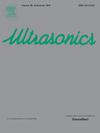低振幅脉冲穿插组织切片治疗金黄色葡萄球菌生物膜对外科补片的影响
IF 4.1
2区 物理与天体物理
Q1 ACOUSTICS
引用次数: 0
摘要
超声组织切片法在破坏疝补片上的细菌生物膜方面显示出巨大的潜力。通过减少必要的治疗时间,可以进一步加强治疗。在这项研究中,我们评估了在每个高振幅组织图脉冲之间的低振幅脉冲间隔对不同治疗持续时间的治疗效果的影响。低幅脉冲在1.05 MHz频率下由20到500个周期组成,相对压力振幅从0(无低幅脉冲)到−1.9 MPa不等。扫描速度分别为0.2 mm/s、0.8 mm/s和1.5 mm/s (0.18 BW/s、0.72 BW/s、1.35 BW/s,其中BW为波束宽度)。扫描线之间的步长分别为0.2 mm和0.4 mm (0.18 BW和0.36 BW)。脉冲重复频率(PRF)在62.5 ~ 500 Hz之间变化,低幅值脉冲(如果存在)位于组织化脉冲后500μs。在治疗脉冲之间加入低振幅脉冲,且该低振幅脉冲的机械指数(MI)超过1.5时,网格样品上的菌落形成单位数量显著减少。较慢的扫描速度也增加了生物膜的破坏,但除了0.18 BW/s的非常慢的扫描速度外,效果要明显得多。因此,二次脉冲的使用将处理时间从20.9分钟/平方厘米减少到2.78分钟/平方厘米。当不包括二次脉冲时,改变PRF没有影响,但当存在二次脉冲时,较高的PRF会增加生物膜破坏。二次脉冲的周期数对测试值范围的影响也很小。本文章由计算机程序翻译,如有差异,请以英文原文为准。

Impact of low-amplitude pulse interspersed with histotripsy treatment of Staphylococcus aureus biofilms on Surgical Mesh
Ultrasound histotripsy has shown great potential for destroying bacteria biofilms on hernia mesh. The therapy could be further enhanced by reducing the necessary treatment times. In this study, we evaluated the inclusion of a low-amplitude pulse spaced between each of the high-amplitude histotripsy pulses on the effectiveness of the therapy for different treatment durations. The low-amplitude pulse consisted of between 20 and 500 cycles at 1.05 MHz with rarefactional pressure amplitudes varying from 0 (no low-amplitude pulse) to −1.9 MPa. The scan speed was varied as 0.2 , 0.8 , and 1.5 (0.18 BW/, 0.72 BW/, 1.35 BW/ where BW is beamwidth). The step size between scan lines was 0.2 mm or 0.4 mm (0.18 BW and 0.36 BW). The pulse repetition frequency (PRF) was varied between 62.5 and 500 Hz with the low-amplitude pulses (if present) positioned after the histotripsy pulses. The number of colony-forming units on the mesh samples was significantly reduced when a low-amplitude pulse was included between the therapy pulses provided the mechanical index (MI) of the low-amplitude pulse exceeded 1.5. Slower scan speeds also increased biofilm destruction, but the effect was much less pronounced except for very slow scan speeds of 0.18 BW/. Thus, the use of secondary pulses reduced treatment times from 20.9 to 2.78 . Varying the PRF had no impact when the secondary pulse was not included, but biofilm destruction increased at higher PRFs when a secondary pulse was present. The number of cycles in the secondary pulse also had little impact over the range of values tested.
求助全文
通过发布文献求助,成功后即可免费获取论文全文。
去求助
来源期刊

Ultrasonics
医学-核医学
CiteScore
7.60
自引率
19.00%
发文量
186
审稿时长
3.9 months
期刊介绍:
Ultrasonics is the only internationally established journal which covers the entire field of ultrasound research and technology and all its many applications. Ultrasonics contains a variety of sections to keep readers fully informed and up-to-date on the whole spectrum of research and development throughout the world. Ultrasonics publishes papers of exceptional quality and of relevance to both academia and industry. Manuscripts in which ultrasonics is a central issue and not simply an incidental tool or minor issue, are welcomed.
As well as top quality original research papers and review articles by world renowned experts, Ultrasonics also regularly features short communications, a calendar of forthcoming events and special issues dedicated to topical subjects.
 求助内容:
求助内容: 应助结果提醒方式:
应助结果提醒方式:


